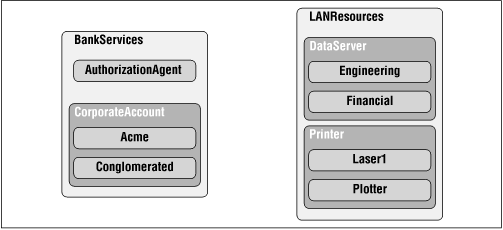Naming Service
The Naming
Service is arguably the most commonly used service in the CORBA
family. We used the Naming Service in our CORBA example in Chapter 3 to look up our CORBA-based
Solver object. The Naming Service provides a
means for objects to be referenced by name within a given naming
context. A naming context is a scoping mechanism for names, similar
in philosophy to class packages in Java. Within a particular context,
names must be unique, and contexts can be nested to form compound
contexts and names. Figure 2.1 shows two naming
contexts in the form of Venne diagrams: one, whose topmost context is
named “BankServices,” defines names for objects in a
banking application; the other, named “LANResources,”
defines names for network resources such as printers, compute
servers, data servers, etc. The “BankServices” naming
context contains a single object named
“AuthorizationAgent,” and a subcontext named
“CorporateAccount.” The “LANServices” context
contains a “DataServer” context and a
“Printer” context, and each of these contains two named
objects.
 |
Agents in a distributed system can add named objects to the Naming Service by binding objects to a particular name within a context. Other agents can then look up these objects by resolving their names into object references. The name of an object is made up of a sequence of name components ...
Get Java Distributed Computing now with the O’Reilly learning platform.
O’Reilly members experience books, live events, courses curated by job role, and more from O’Reilly and nearly 200 top publishers.

